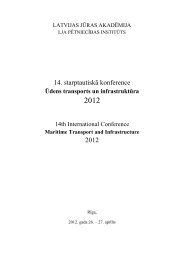Latvian Maritime academy
Latvian Maritime academy
Latvian Maritime academy
Create successful ePaper yourself
Turn your PDF publications into a flip-book with our unique Google optimized e-Paper software.
STCW compliance 2012<br />
The International Convention on Standards of Training, Certification and Watchkeeping for<br />
Seafarers (STCW) aims to achieve for the shipping industry what increased technology has so far failed<br />
to deliver, namely, a reduction of 80 % in accidents attributable to human error on board ship. Proper<br />
training and evaluation can make a real difference to these damning statistics.<br />
Major revisions to the STCW Convention and its associated Code have been adopted at a<br />
Diplomatic Conference in Manila which the authors were privileged to attend in the Philippines, thereby<br />
ensuring that the necessary global standards will be in place to train and certify seafarers to operate<br />
technologically advanced ships for some time to come. The amendments, to be known as “The Manila<br />
amendments to the STCW Convention and Code” are set to enter into force on January 1, 2012 under the<br />
tacit acceptance procedure and are aimed at bringing the Convention and Code up to date with<br />
developments since they were initially adopted in 1978 and further revised in 1995; and to enable them to<br />
address issues that are anticipated to emerge in the foreseeable future.<br />
Amongst the amendments adopted, there are a number of important changes in each chapter of the<br />
Convention and Code, including:<br />
# Improved measures to prevent fraudulent practices associated with certificates of competency and<br />
strengthen the evaluation process (monitoring of Parties’ compliance with the Convention);<br />
# Revised requirements on hours of work and rest and new requirements for the prevention of drug<br />
and alcohol abuse, as well as updated standards relating to medical fitness standards for seafarers;<br />
# New certification requirements for able seafarers;<br />
# New requirements relating to training in modern technology such as electronic charts and<br />
information systems (ECDIS);<br />
# New requirements for marine environment awareness training and training in leadership and<br />
teamwork;<br />
# New training and certification requirements for electro-technical officers;<br />
# Updating of competence requirements for personnel serving on board all types of tankers,<br />
including new requirements for personnel serving on liquefied gas tankers;<br />
# New requirements for security training, as well as provisions to ensure that seafarers are properly<br />
trained to cope if their ship comes under attack by pirates;<br />
# Introduction of modern training methodology including distance learning and web-based learning;<br />
# New training guidance for personnel serving on board ships operating in polar waters; and<br />
# New training guidance for personnel operating Dynamic Positioning Systems.<br />
The authors suggested that the successful closure of the Conference should be seen as marking the<br />
beginning of strenuous efforts at three levels. Firstly, it is necessary to commence, at the earliest possible<br />
opportunity, work to translate the revised STCW requirements into national regulations – with the aim of<br />
expediting their implementation. Secondly, with the aim of familiarizing STCW Parties with the revised<br />
requirements it is necessary to deliver, as appropriate, technical assistance through IMO’s Integrated<br />
Technical Co-operation Programme and to provide useful technical advice on the STCW Convention and<br />
the STCW Code as a whole. Thirdly, it is important to initiate action, as may be necessary, to ensure the<br />
full and effective implementation and rigorous enforcement of the revised STCW Convention and Code<br />
when the amendments come into force on the agreed date of 1 January 2012.<br />
Delivery of training on-board – challenging MET to change<br />
The United States Distance Learning Association (USDLA), founded in 1987, defines distance<br />
learning (hereinafter - DL) as “the acquisition of knowledge and skills through mediated information and<br />
instruction, encompassing all technologies and other forms of learning at a distance.” According to<br />
B. Willis [23] “the term distance learning refers to a teaching-learning arrangements in which the learner<br />
and teacher are separated by geography, time, and technology (i.e. voice, video, printed data, CBT, CAL,<br />
CAI), and Internet is used to bridge the instructional gap”. Supporting the above opinion, Garrison (1989)<br />
concedes that the main characteristic of DL is the non-contiguity of the teacher and learner.<br />
Most MET institutions use CBT as a part of their educational process. However, some people (Dinu,<br />
2000) are of the opinion that DL is the answer to problems related to maritime institutes such as “non<br />
permanent attendance at courses, seminars and laboratories.” [6] Lewarn (2001) states that, “if MET<br />
providers do not start developing their own future in a coherent, structured & systematic way, then others<br />
33
















